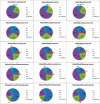Lung cancer incidence trends by gender, race and histology in the United States, 1973-2010
- PMID: 25822850
- PMCID: PMC4379166
- DOI: 10.1371/journal.pone.0121323
Lung cancer incidence trends by gender, race and histology in the United States, 1973-2010
Abstract
Background: Lung cancer (LC) incidence in the United States (US) continues to decrease but with significant differences by histology, gender and race. Whereas squamous, large and small cell carcinoma rates have been decreasing since the mid-80s, adenocarcinoma rates remain stable in males and continue to increase in females, with large racial disparities. We analyzed LC incidence trends by histology in the US with an emphasis on gender and racial differences.
Methods: LC incidence rates from 1973-2010 were obtained from the SEER cancer registry. Age-adjusted incidence trends of five major histological types by gender and race were evaluated using joinpoint regression. Trends of LC histology and stage distributions from 2005-2010 were analyzed.
Results: US LC incidence varies by histology. Squamous, large and small cell carcinoma rates continue to decrease for all gender/race combinations, whereas adenocarcinoma rates remain relatively constant in males and increasing in females. An apparent recent increase in the incidence of squamous cell carcinoma and adenocarcinoma since 2005 can be explained by a concomitant decrease in the number of cases classified as other non-small cell carcinoma. Black males continue to be disproportionally affected by squamous LCs, and blacks continue to be diagnosed with more advanced cancers than whites.
Conclusions: LC incidence by histology continues to change over time. Additional variations are expected as screening becomes disseminated. It is important to continue to monitor LC rates to evaluate the impact of screening on current trends, assess the continuing benefits of tobacco control, and focus efforts on reducing racial disparities.
Conflict of interest statement
Figures



References
-
- Travis WD, Lubin J, Ries L, Devesa S. United States lung carcinoma incidence trends: Declining for most histologic types among males, increasing among females. Cancer. 1996;77(12): 2464–70. - PubMed
-
- Centers for Disease Control and Prevention (CDC). Smoking-attributable mortality, years of potential life lost, and productivity losses—United States, 2000–2004. MMWR Morb Mortal Wkly Rep. 2008;57(45): 1226–8. - PubMed
-
- Haiman CA, Stram DO, Wilkens LR, Pike MC, Kolonel LN, Henderson BE, et al. Ethnic and racial differences in the smoking-related risk of lung cancer. N Engl J Med. 2006;354(4): 333–42. - PubMed
Publication types
MeSH terms
Grants and funding
LinkOut - more resources
Full Text Sources
Other Literature Sources
Medical

